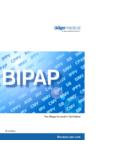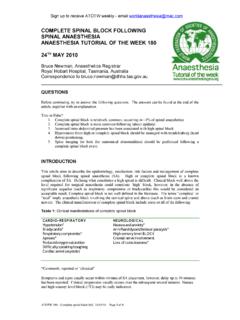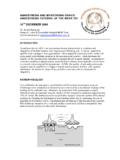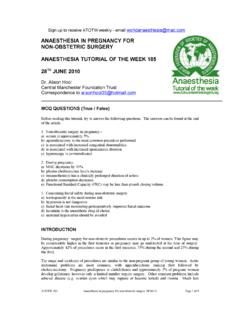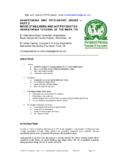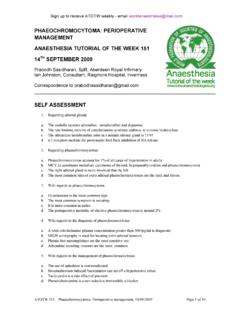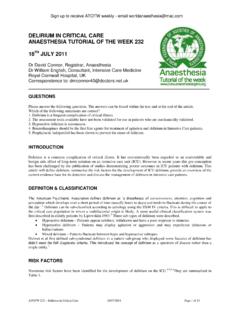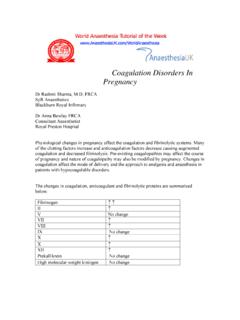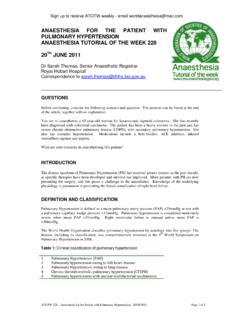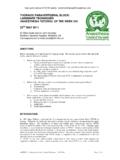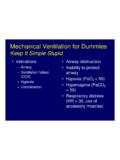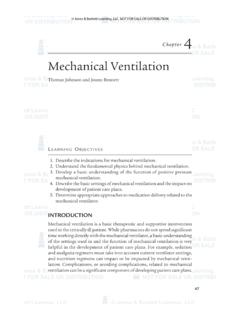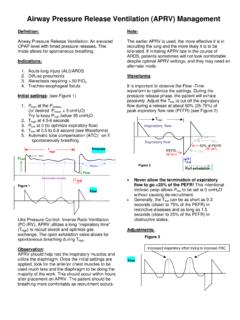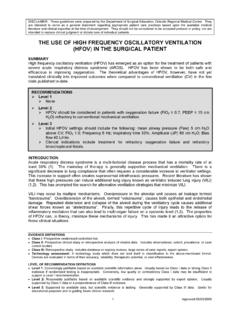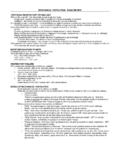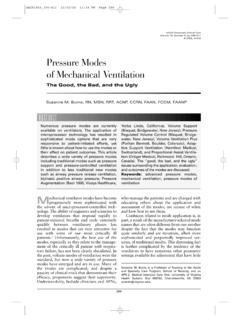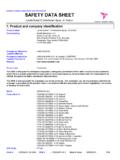Transcription of Airway Pressure Release Ventilation: Theory and Practice
1 Airway Pressure Release ventilation (APRV) is a relatively new mode ofventilation, that only becamecommercially available in the UnitedStates in the mid-1990s. Airway pressurerelease ventilation produces tidalventilation using a method that differsfrom any other mode. It uses a Release ofairway Pressure from an elevatedbaseline to simulate expiration. Theelevated baseline facilitates oxygenation,and the timed releases aid in carbondioxide of APRV include lowerairway pressures, lower minuteventilation, minimal adverse effects oncardio-circulatory function, ability tospontaneously breathe throughout theentire ventilatory cycle, decreasedsedation use, and near elimination ofneuromuscular blockade. Airway pressurerelease ventilation is consistent with lungprotection strategies that strive to limitlung injury associated with mechanicalventilation.
2 Future research will probablysupport the use of APRV as the primarymode of choice for patients with acutelung injury. (KEYWORDS: acute lunginjury, Airway Pressure releaseventilation, alveolar recruitment, alveolarderecruitment, lung protective strategies) Airway Pressure Release ventilation (APRV) isa mode of ventilation that was first describedin ,2It uses a philosophy that differsfundamentally from that of conventionalventilation. Whereas conventional modes ofAACN Clinical IssuesVolume 12, Number 2, pp. 234 246 2001, AACN ventilation begin the ventilatory cycle at abaseline Pressure and elevate Airway pres-sure to accomplish tidal ventilation (Figure1), APRV commences at an elevated baselinepressure (similar to a plateau Pressure ) andfollows with a deflation to accomplish tidalventilation (Figure 2).
3 In addition, duringAPRV, spontaneous breathing may occur ateither the plateau Pressure or deflation pres-sure levels. This article provides a detailedexamination of the terminology, indications,theoretical benefits, advantages, and disad-vantages of APRV as well as a discussion ofapplication and weaning procedures. Airway Pressure ReleaseVentilation DefinedAirway Pressure Release ventilation has beendescribed as continuous positive Airway pres-sure (CPAP) with regular, brief, intermittentreleases in Airway ,4 The releasephase results in alveolar ventilation and re-moval of carbon dioxide (CO2). Airway pres-sure Release ventilation , unlike CPAP, facili-tates both oxygenation and CO2clearanceand originally was described as an improvedmethod of ventilatory support in the presenceof acute lung injury (ALI) and inadequate ,5 Airway Pressure Release ventila-tion is capable of either augmenting alveolarAirway Pressure ReleaseVentilation: Theory and PracticeP.
4 Milo Frawley, RN, MS,* and Nader M. Habashi, MD From *Maryland ExpressCare and Department ofCritical Care Medicine, University of Maryland MedicalCenter, Baltimore, requests to P. Milo Frawley, RN, MS, Mary-land ExpressCare, TGR25C, University of MarylandMedical Center, 22 South Greene Street, Baltimore, 12, No. 2 May 2001 APRV: Theory AND Practice 235ventilation in the spontaneously breathing pa-tient or accomplishing complete ventilation inthe apneic CPAP level drivesoxygenation, while the timed releases aid , APRV is a time-triggered, pres-sure-limited, time-cycled mode of mechanicalventilation. In addition, APRV allows unre-stricted, spontaneous breathing throughoutthe entire ventilatory cycle (Table 1).
5 Advan-tages of APRV include: significantly lowerpeak/plateau Airway pressures for a giventidal volume; the ability to superimpose spon-taneous breathing throughout the ventilatorycycle; decreased sedation; and near elimina-tion of neuromuscular blockade ,8 Fea-tures that distinguish APRV from other modesof mechanical ventilation include sponta-Figure volume targeted ventilation , , synchronized intermittent mandatory ventilation (SIMV). Any mechanically delivered breath will be defined by its trigger, limit, and cycle off feature. In SIMV, thebreath will be triggered by either the patient or by time, the volume delivered will limit the breath, and time will cy-cle the breath off into exhalation.
6 Cms of H2O = centimeters of Pressure Release ventilation : this can also be defined by a trigger, limit, and cycle off , unlike other modes of ventilation , the trigger (time) initiates a drop in Airway Pressure . The amount ofpressure change will be the limit. The cycle off will occur because of time. Airway Pressure then returns to thebaseline. Cms of H2O = centimeters of FRAWLEY AND HABASHIAACN Clinical Issuesneous breathing throughout the ventilatorycycle and an intermittent Pressure releasephase that results in a brief decrease in lungvolume to assist ,2 History of MechanicalVentilationThe basic principles of ventilator design andmanagement were founded upon patientswho developed nonparenchymal respiratoryfailure ( , polio).
7 In the absence of ade-quate research, those same principles wereapplied to patients with parenchymal respira-tory failure as well ( , ALI). Mode selectionoften was based on availability and simplicityof the ventilator, user experience, and tradi-tion, because little evidence existed to 1993, the American College of ChestPhysicians (ACCP) consensus conferencefailed to agree on an optimum mode ofventilation for any disease state or an opti-mum method of weaning patients from me-chanical ventilation . 9(p1834)The ACCP agreed that well-controlled clinical trialsthat defined the indications and uses ofspecific modes of ventilation were technology must scientifically show adistinct advantage in safety, expense, easeof operation, or therapeutic ,11 Despite more than 30 years since itsrecognition, acute respiratory distress syn-drome (ARDS)
8 Continues to have a 30% to50% mortality ,13 Recently, discovery ofthe potential for mechanical ventilation toproduce ventilator-associated lung injury hasresulted in the development of new lungprotective protective strate-gies include those described in the theopen lung approach promoted by Amato open lung approach uses reducedtidal volumes (6 mL/kg) to prevent high-vol-ume lung injury and over-distension of air-spaces. In addition, Amato et ele-vated end expiratory Pressure (averagepositive end-expiratory Pressure [PEEP] 16cm water Pressure ), to prevent low volumelung injury from cyclic Airway recently completed ARDSNet studycompared conventional tidal volume (12mL/kg) to reduced tidal volume (6 mL/kg).
9 13 The results of the ARDSNet trial13and astudy conducted by Amato et anassociation between reduced tidal volumeand improved outcome. Although the ARD-SNet trial targeted similar PEEP levels in bothits groups, study protocols for maintainingsaturation resulted in higher levels of setPEEP in the low tidal volume group. In addi-tion, to maintain similar targets for PaCO2,the low tidal volume group had much higherrespiratory frequencies, resulting in the de-TABLE 1 Classification of Common Modes of Mechanical VentilationSpontaneousModeTriggerLimitCy cle OffBreathingFlow of GasA-CTime or patientVolumeTimeNoConstant(volume)A-CTi me or patientPressureTimeNoDecelerating(pressu re)SIMVTime or patientVolumeTimeYesConstant(volume)PSVP atientPressureFlow of gasNoDeceleratingPRVCTime or patient*VolumeTimeNoDeceleratingAPRVTime PressureTimeYesDeceleratingNote: A mechanically delivered breath is made up of three distinct phases.
10 The Trigger initiates the breath; the Limit will stop thebreath from increasing, but does not initiate exhalation; and the Cycle Off, that switches the breath from inspiration to exhala-tion. Beyond this, modes may or may not allow unsupported, spontaneous breathing. The inspired gas may be delivered usingeither a constant or decelerating flow of gas.*This mode is designed for patients with no breathing capacity, though they are able to trigger assist control; SIMV synchronized intermittent mandatory ventilation ; PSV Pressure support ventilation ; PRVC Pressure regulated volume control; APRV Airway Pressure Release 12, No. 2 May 2001 APRV: Theory AND Practice 237velopment of intrinsic PEEP. Therefore, therole of elevated levels of end expiratorypressure (PEEP) on survival of the low tidalvolume group may have been obscured.
